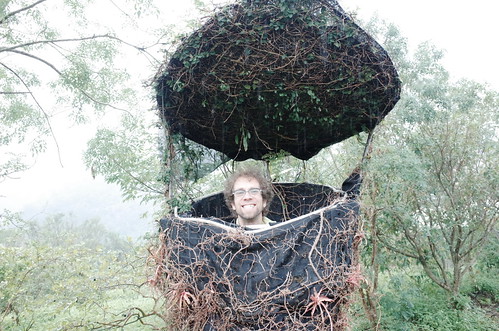By Joshua Samuel Brown and Stephanie Huffman, Special to the Canadian Chamber of Commerce in Taiwan
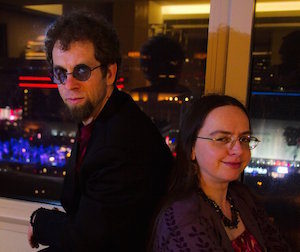
Image Source: Tobie Openshaw
For a long time I scoffed at luxury hotels, but this was largely because luxury hotels were way out of my reach. (“A Bachelor’s Degree in Creative Writing is your ticket to the finer things in life” said no undergraduate advisor ever.)
Then I began my illustrious career as a guidebook writer, and not only could I still not afford to stay in luxury hotels but I was obliged to visit them regularly to review them on the sly, conducting clandestine inspections of some of Asia’s best known five-stars by day bedding down in hostels by night.
This oft-used technique is employed by many an honest travel writer – for a full report on the potential pitfalls of this method, click over to My Parents are Little People.
But Taipei’s hostels are no place to bring a lady, especially a jet-lagged first time visitor who’s come to Taiwan sight unseen as part of a strangely-hatched literary mission / life transition.
So when Paul Ou, Marketing Communications Manager at the Grand Hyatt Taipei, offered Stephanie and I a soft landing place at the start of our Formosa Moon Research Trip, we accepted with great gratitude. The two-day stay would give us a place to relax in style and to plan out the next three months of travel and writing around Taiwan, a trip during which luxury would definitely not be the planned focus.
We had arrived in town on New Year’s Eve, and as even the humbler hotels were booked we’d spent the previous two nights couch-surfing. Still bedraggled and road-weary, we were whisked up to our apartment on the 20th floor to begin our 48 hour luxury package.
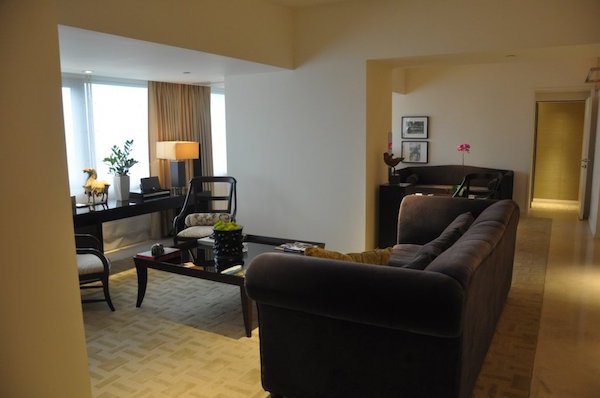
Yes, apartment. With two bathrooms (one more than our actual apartment in Portland, Oregon), a huge living room that doubled as our office (or would have if we’d gotten any actual work done), a bedroom fit for a king in more ways than just the king-sized mattress, the Grand Executive Suite deserved to be called no less.
At the risk of showing my age, let’s start with the bathrooms.
The main one boasted a rainforest shower, a tub big enough for a romantic evening with two full-grown mermaids and a heated toilet with a bewilderingly soothing number of water-spouting accoutrements.
The living room bathroom had the same cyber-toilet but lacking either the tub or shower seemed more geared towards executive business. The living room water closet also lacked wall-to-wall and nigh floor-to-ceiling windows, which is noteworthy only in that it was literally the only room in the entire suite in which one could not look out upon everything in Taipei city south, east (and in one spot close to the front door) west of Taipei 101.
In mathematical terms, our suite boasted 3/4 of a 360 degree view, which according to Siri means our suite offered a 270 degree view of Taipei (and the fact that I needed to bother Siri on such a stunningly simple calculation should tell you all you need to know about why I chose a career in writing).
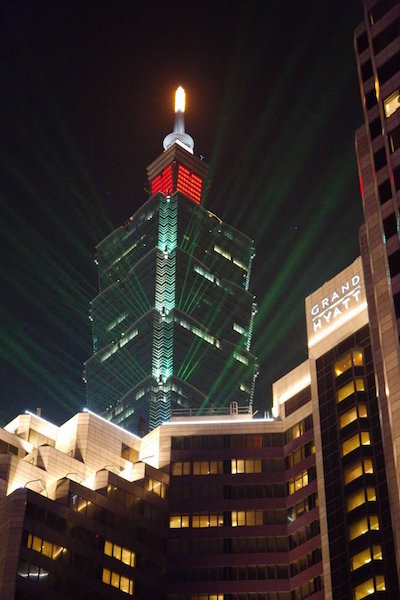
Image Source: Tobie Openshaw
The view, showing Taipei in its busy glory by day and neon splendor by night, could be blocked out at the push of a bank of buttons that raised and lowered blinds, sent blackout curtains sliding from hidden compartments, turned lights on and off, operated the large flat screen TV and would call room service to order kippers for the mermaids in the bathtub.
We did not send for room service (though it was an 24/7 option), opting instead to try as many of the Grand Hyatt’s dozen-or-so eating spots as possible over our 48 hour stay. The Pearl Liang restaurant served up authentic Cantonese fare with just a hint of fusion, while the first floor café had a buffet rivaling the Dag Hammarskjöld Plaza greenmarket in its international bona-fides.
Our favorite spot turned out to be the 22nd floor Grand Club Lounge, both for its daily breakfast, all-day snack selection and evening cocktail parties. It was during one of these parties where we reconnected with an astrophysicist we’d met on the flight over, discussing over hors d’oeuvres both the smallness of the world and the vastness of the universe.
We were also taken to wander avec chaperon through some of the other rooms at the Grand Hyatt (one of the perks of travel writing) and were impressed by managements’ overall attention to detail. All hotels keep a few books in their rooms, but these are usually either decorative Reader’s Digest type collections, or religious tomes designed to dissuade the lonely traveler from doing something they might regret after having a few too many from the mini-bar.
But each of the rooms we visited (including our own) had books worth buying – graphic novels, guides to astronomy, short story collections. As writers ourselves, we were encouraged. Not enough to tear us away from the bathtub, 270 degree view of Taipei, flat-screen TV complete with first-run pay-per-view movies and other diversions to do any actual work. But…almost.
Cuisine, accommodations worthy of a Sultan (of Brunei or Swing, take your pick) and being allowed to spend time recuperating from a lengthy journey while preparing for an even lengthier one was but a part of our 48 hour luxury package.
The other part was a three-hour long treatment at the Grand Hyatt’s brand new Oasis Spa. But for that description, I’ll pass the keyboard to the other half of the Formosa Moon Team.

Image Source: Tobie Openshaw
Stephanie?
What did I do to deserve such luxury?
Before our session had begun, we’d been invited to soak in the gender-separated spa area. I hit the sauna first, hoping to sweat out the processed-food toxins from many days of travel, but the sauna proved too hot.
Bailing after just a few minutes, I moved to the steam room, settling into the overall vibe, listening to the mellow hiss of steam. Everything in the spa had clearly been designed with comfort and serenity in mind.
The spa’s centerpiece, the main hot pool, was designed to allow the water to rest at the stone pool’s upper edge. As I entered it spilled over the sides into the drain surrounding the pool. After I had settled into a comfortable spot the water stilled and again the water level rode right to the pool edge.
The scene was quiet and relaxing. A small cold pool sat nearby. I worked myself up to walk down the steps and submerge myself to my shoulders. After a few breaths I returned to the heated waters of the main pool.
I was repeating this process, alternating between hot and cold when my masseuse came in to get me, wrapping me in a thick white robe before bringing me upstairs to our couples massage room. Joshua was already seated, soaking his feet in a brine of scented water, sipping flower tea in (uncharacteristic) silence.
I joined him as our masseuses readied the tables while we drank a flower tea in silence. We were then beckoned to our heated massage tables, where we, after being slathered in black mud, were wrapped in a coating of thick plastic and covered in heavy blankets. My masseuse applied additional mud onto my face with a soft brush, which I found quite soothing. I’d done many spa sweats in New Mexico and had always enjoyed the experience.
It had been several years since I had done such a sweat, and I was floating on a pleasant cloud of heated mud and perspiration.
My reverie is interrupted suddenly.
“I feel like a butterball turkey roasting in its own juices.”
Joshua, apparently, has reached his own heat tolerance, and begins unwrapping himself prematurely from his mud cocoon. He makes a beeline for the shower.
Not long after, my masseuse gestures for me to sit up. As I ease into a standing position, a mixture of mud and sweat pours down my body. The masseuse folds the plastic around my calves, allowing me to waddle to the shower without dripping on the floor. After washing in a beautifully warm shower, I join Joshua on the couch and await the next round.
We’re given a light snack during our break, mochi – a sweetened glutinous rice cake – and more tea. The sauna mud wrap having begun the process of melting away the soreness from days of awkward sleeping arrangements, I’m now ready for the massage to evaporate the rest. I am not disappointed – my masseuse knows her trade well, using enough pressure to work my muscles without pain.
After the massage, we’re invited to relax again on the couch with more flower tea before beginning the last part of the treatment – the facial. Lying still on the table, a seemingly endless array of gentle paintbrushes caress my skin with sweet smelling lotion. Again, I find myself drifting away.
The facial complete, we are offered more tea and advised to let the oils and other unguents from the various stages of the Calm treatment to to soak into our skin for the rest of the day before showering. Every inch of my skin velvety soft, Joshua and I head upstairs for a mid-day rest, Calm, relaxed and serene.
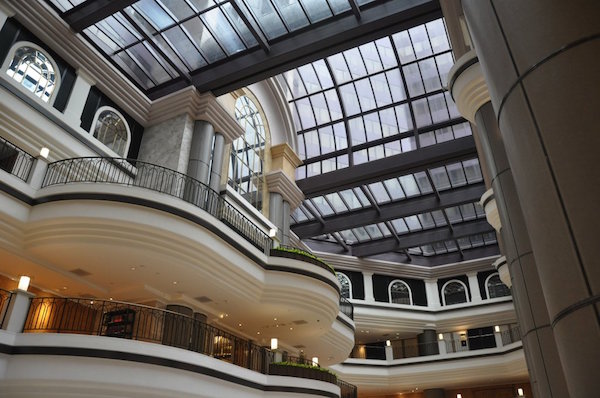
Image Source: Stephanie Huffman
Joshua Samuel Brown has authored or co-authored 13 books, including Vignettes of Taiwan and a dozen or so guides for guidebook titan, Lonely Planet. He and his partner Stephanie Huffman are in Taiwan working on a collaborative project called Formosa Moon, to be published by Things Asian Press in 2018. To learn more about Formosa Moon, check out www.josambro.com or their Facebook page at Honey Trekkers.
Grand Hyatt Taipei
2, SongShou Road, Taipei, Taiwan, 11051
- Tel: +886 2 2720 1234
- taipei.grand@hyatt.com



